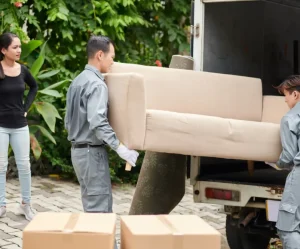How to pack blankets for moving is more important than it might seem. Blankets and bedding are bulky, take up space, and can easily get dirty or damaged if not packed correctly. Poor packing can lead to wasted space, clutter, or even mold during storage. Whether you’re relocating locally or preparing for long-distance or storage moves, packing these items the right way matters. This guide will walk you through smart, space-saving tips for packing bedding and choosing the right materials. You’ll also learn how to use blankets for packing other items and avoid common mistakes. Let’s make your move smoother and more organized from the start.
Moving Supplies You’ll Need for Packing Bedding and Blankets
To pack your bedding and blankets the right way, having the right supplies makes all the difference. Here’s a quick list:
- Vacuum-seal bags – Save space and protect bulky items like comforters.
- Large boxes or plastic totes – Ideal for storing folded bedding and labeling clearly.
- Plastic garbage bags – Great as temporary covers or for loose pillows.
- Permanent marker & labels – For marking boxes like “Bedroom – Blankets” or “First Night Bedding.”
- Packing tape & plastic wrap – Seal boxes securely and wrap items to keep out dust.
These basic materials make packing bedding and packing blankets for moving clean, easy, and efficient.
Why It’s Important to Pack Blankets Properly When Moving

When it comes to moving, many people focus on large furniture and fragile items—but packing blankets for moving the right way is just as important. Blankets and bedding may not be breakable, but if packed incorrectly, they can collect dust, develop mold, get wrinkled, or even take up unnecessary space.
Below are key reasons why packing bedding and blankets properly can make your move smoother, cleaner, and more efficient.
1. Preventing Dust, Mold, and Damage
Blankets and bedding are soft materials that can easily collect dust, moisture, or odors if not packed in sealed containers or clean moving boxes. If you’re storing items for a long time or moving during a humid or rainy season poor packing can lead to mold growth, especially on thick comforters or wool blankets.
2. Saving Space in Boxes and Moving Trucks
Blankets can be bulky. If not folded and packed correctly, they can take up unnecessary space in your moving boxes or moving truck. This can lead to more trips, wasted packing materials, and even increased moving costs.
By rolling or compressing your bedding into vacuum-sealed bags, you’ll save space and make room for other essentials. Efficient packing blankets for moving can also help balance heavy items inside the truck, keeping things stable during transit.
3. Keeping Blankets Clean and Organized
One of the last things you want to do in your new home is unpack a pile of tangled or dirty bedding. When you pack blankets properly, you ensure everything stays clean, fresh, and ready to use.
Label each bag or box so you know exactly where to find what you need. This is especially useful if you’re planning to unpack in stages or store seasonal blankets separately.
4. Avoiding Wrinkles and Compression for Delicate Bedding
Some bedding, especially those made of silk, down, or specialty fabrics, can get permanently wrinkled or lose their loft if they are tightly stuffed or compressed for too long. Proper packing of bedding preserves the look and feel of your items.
You may read about How To Move A Mattress?
How to Pack Blankets and Pillows for Moving
Moving day can get overwhelming if you’re not organized—especially when it comes to soft items like blankets and pillows. Though they aren’t fragile, they do take up space and can easily get dirty or damaged if not packed properly.
This step-by-step guide will show you how to handle packing bedding, with tips on storing blankets for packing and how to keep your pillows fresh, clean, and easy to find after the move.
1. Sort by Use: Everyday, Seasonal, and Decorative
Before you begin packing blankets for moving, take time to sort them by usage:
- Everyday blankets and pillows – You’ll want quick access to these.
- Seasonal bedding – Store these for longer-term use.
- Decorative items – Pack them carefully to maintain shape and style.
Sorting helps with organization and makes unpacking much easier in your new space.
2. Wash and Dry Before Packing
Always wash and fully dry your bedding before packing. This prevents dust, odors, or mildew during transit or storage. Clean blankets for packing will also keep your other belongings smelling fresh.
Important: Only pack items once they are 100% dry to avoid mold growth inside bags or boxes.
3. Fold or Roll: What’s Better?
When packing bedding, you have two main options: folding or rolling.
Folding – Pros:
- Saves space in boxes
- Creates flat, stackable layers
Folding – Cons:
- Can cause creases in delicate bedding
Rolling – Pros:
- Reduces wrinkles
- Easier to fit into oddly-shaped containers
Rolling – Cons:
- May take up more space if not compact
Choose what works best based on your storage space and the type of blanket or pillow.
4. Use Vacuum-Sealed Bags to Save Space
Vacuum-sealed bags are a top choice for packing blankets for moving. They compress bulky bedding and pillows, saving tons of space in your moving truck or storage bin.
Best for:
- Comforters
- Down blankets
- Pillows you won’t use immediately
Avoid vacuum-sealing delicate or feather pillows, as the compression can ruin their shape.
5. Wrap with Plastic or Use Large Plastic Bags
If vacuum bags aren’t an option, use plastic trash bags or clear storage bags to protect your blankets for packing from dust and moisture. For an added layer, wrap bedding in a clean sheet or use lightweight plastic wrap.
Tip: Use zip ties or tape to securely close the bags.
6. Use Moving Boxes or Storage Bins
Pack your bedding into clean, dry moving boxes or large plastic storage bins. Line the bottom with a towel or sheet to prevent dirt from seeping in.
Don’t overpack. Overstuffed boxes can rip or collapse, damaging your bedding.
7. Label Each Box Clearly
Make unpacking stress-free by labeling boxes like:
“Bedroom 1 – Blankets & Pillows”
“Guest Room – Seasonal Bedding”
This helps you prioritize what to unpack first and avoids unnecessary digging through boxes.
8. Pack Pillows Separately
Pillows are best packed loosely to avoid flattening. Here are two easy ways:
- Use clean trash bags for large, soft pillows
- Slip each pillow into a pillowcase, then place them in a plastic bin or box
This keeps them clean and helps maintain their shape during the move.
How to Pack Bedding for Moving | A Simple Guide

When it comes to moving, your bedding might seem like an afterthought. But properly packing bedding helps keep everything clean, organized, and easy to set up in your new home. Whether you’re moving across Los Angeles or across the country, following a smart packing system can make a big difference on moving day.
Here’s how to pack your sheets, pillows, blankets, and comforters the right way.
1. Strip Beds the Day Before the Move
Start by removing all bedding the night before moving day. This includes:
- Sheets
- Pillowcases
- Duvets
- Blankets
- Mattress toppers
Washing and drying them in advance helps ensure your blankets for packing stay fresh and odor-free.
2. Fold Items Neatly
Neatly fold each piece of bedding. This saves space and keeps your moving boxes tidy.
Use the fold method for:
- Flat and fitted sheets
- Pillowcases
- Light blankets
Use the roll method for:
- Thick duvets
- Comforters
- Bulky blankets
Both methods work well, but rolling may reduce wrinkles for delicate fabrics.
3. Use the Right Packing Containers
Proper storage protects your packing blankets for moving from dirt, moisture, and damage. Use:
- Bedding storage bags – Great for compressing large comforters
- Suitcase compartments – Ideal for pillows and sheets
- Clear plastic totes – Easy to stack and see what’s inside
- Vacuum-sealed bags – Save space and keep items dry (avoid for feather pillows)
Avoid using old cardboard boxes for packing bedding unless they are clean and dry.
4. Label Clearly
Labeling your containers helps during unpacking. Try writing:
- “Bedroom 1 – Bedding”
- “Guest Room – Comforters & Sheets”
- “Blankets for Packing – Clean”
This way, you’ll know where every item belongs when you start setting up your new space.
5. Keep First-Night Bedding Separate
Pack one essential bedding set (sheets, pillows, blanket) in a clearly marked overnight bag or separate box. This should be easy to access when you arrive at your new home.
Label it as:
“First Night Bedding – Open First”
This avoids the hassle of digging through boxes after a long day of moving.
Final Tips for Packing Bedding
Make sure everything is clean and dry before packing
Use airtight or water-resistant bags for long-term storage
Don’t overpack boxes with bedding—it can make them too heavy to lift safely
Use blankets for packing delicate items like mirrors or electronics (multi-use!)
Need Help Packing Bedding and Blankets?
At Chamomile Go, we offer professional packing services in Sherman Oaks and surrounding areas. Our team ensures your bedding, blankets, and personal items are packed securely, labeled properly, and moved with care.
Final Thoughts
Packing blankets for moving doesn’t have to be stressful. Keep them clean, dry, and folded or rolled to save space. Use vacuum-seal bags, plastic totes, or labeled boxes to stay organized. Separate essential bedding for your first night to make settling in easier. Protect delicate blankets with plastic wrap or sheets. Smart packing keeps your bedding fresh and ready to use. Need help with packing? Contact Chamomile Go for expert packing and moving services in Sherman Oaks and beyond!
FAQs
1. What Is The Best Way To Pack Blankets For Moving?
The best way is to fold or roll your blankets neatly, place them in vacuum-sealed bags or plastic totes, and label the containers clearly. This method protects them from dust, saves space, and keeps your bedding organized.
2. Should I Wash My Blankets Before Packing Them For A Move?
Yes, always wash and fully dry your blankets before packing. Clean blankets for packing prevent musty smells, dust buildup, and the risk of mold during transport or storage.
3. Can I Use Trash Bags To Pack Blankets?
Yes, clean plastic trash bags can be used as a temporary cover, especially for soft items like pillows or everyday blankets. Just make sure to tie them securely and label them to avoid confusion.
4. Are Vacuum-Seal Bags Good For Packing Bedding And Blankets?
Absolutely. Vacuum-sealed bags are excellent for packing blankets for moving because they compress bulky items and save space in boxes or trucks. However, avoid using them for down or feather pillows, as compression may affect their shape.
5. How Should I Label Blankets When Packing For A Move?
Label boxes or bags with the room name and contents, like “Bedroom 1 – Bedding” or “Living Room – Throw Blankets.” Clear labeling makes unpacking faster and more organized.




